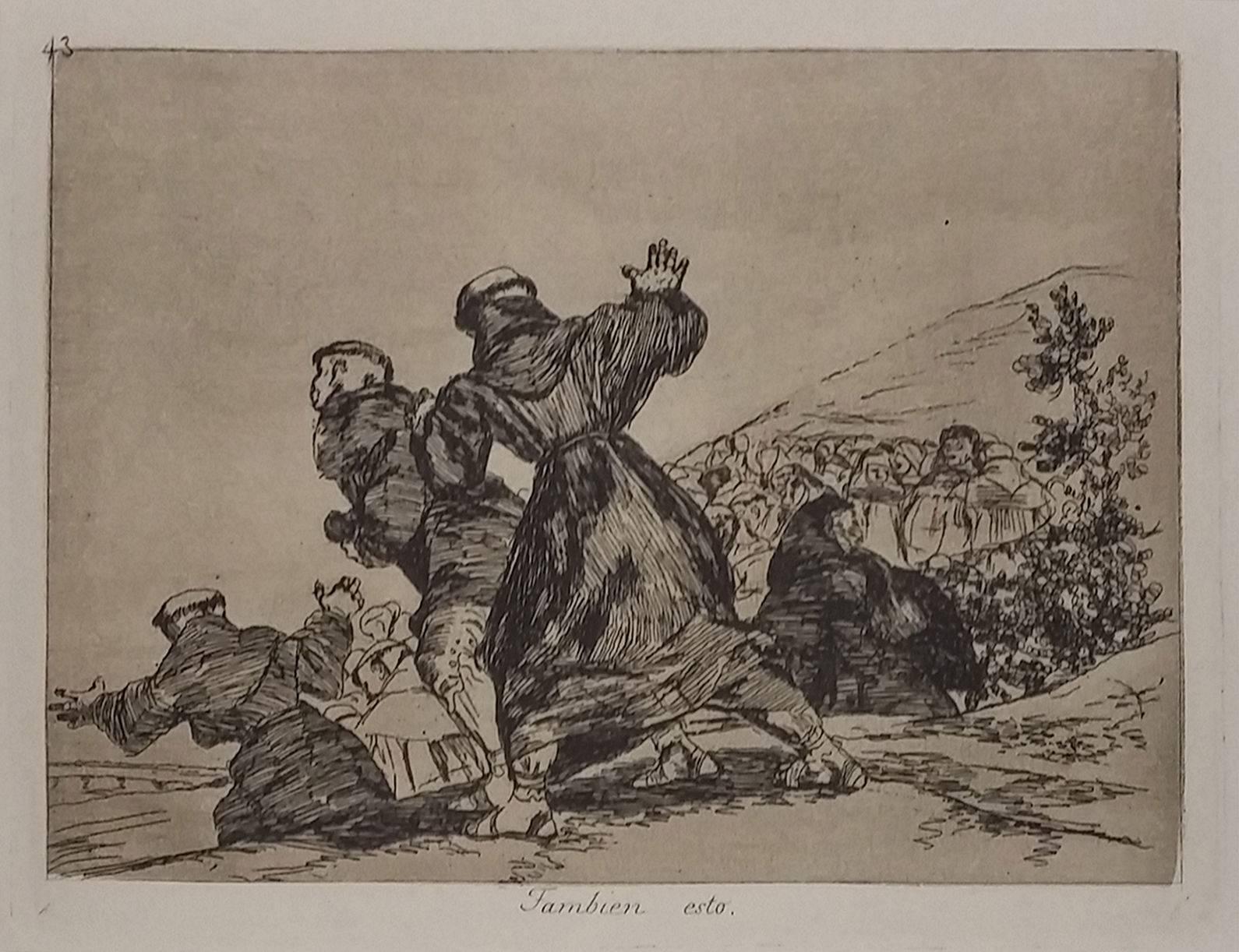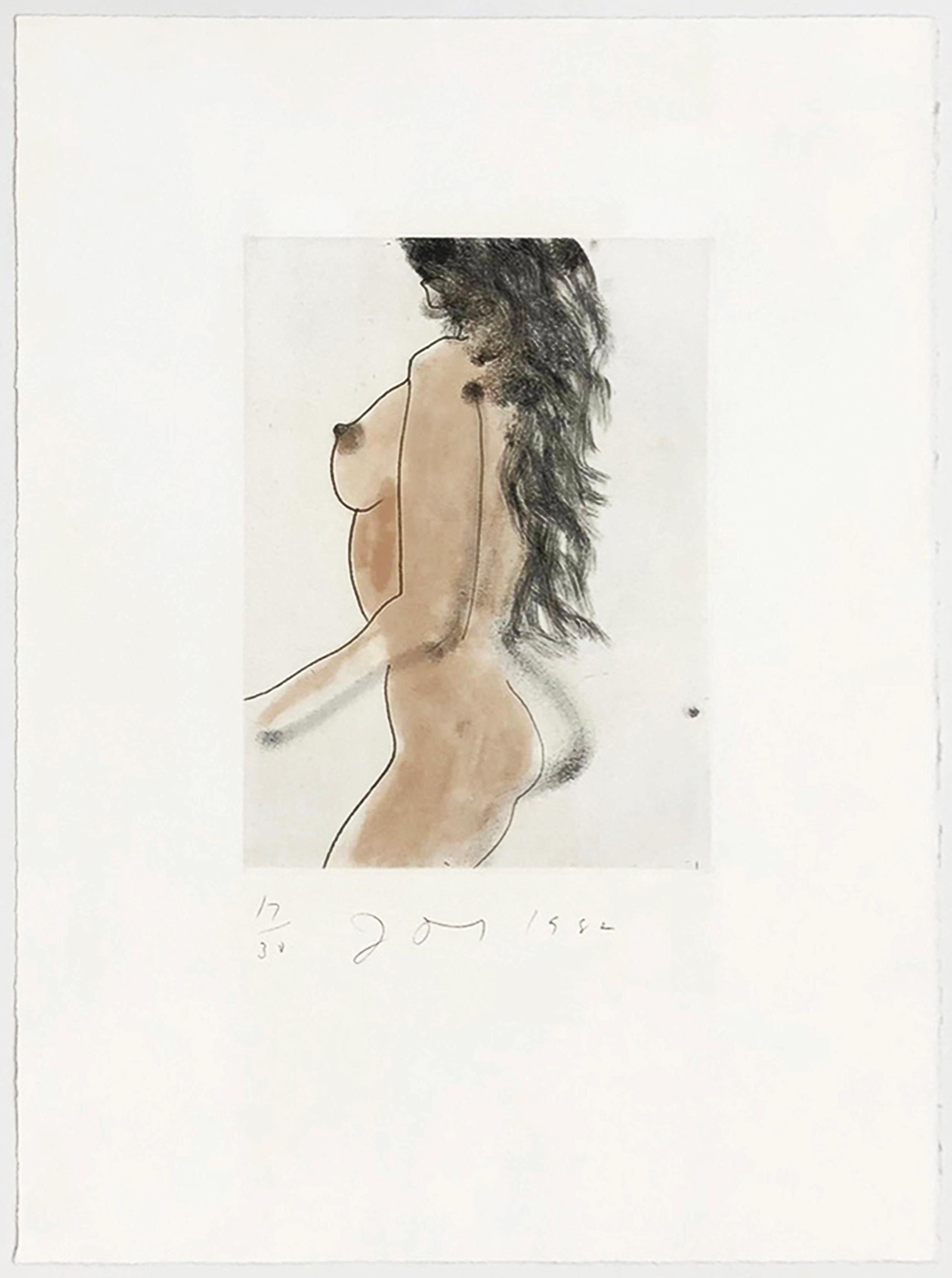Items Similar to Francisco De Goya Disparates Disparate desordenados 1edition original art print
Want more images or videos?
Request additional images or videos from the seller
1 of 6
Francisco GoyaFrancisco De Goya Disparates Disparate desordenados 1edition original art print ca.1815-1819
ca.1815-1819
About the Item
Francisco De Goya (Spain, 1746-1828)
'Disparates. Disparate desordenado (estampa 7)', ca.1815-1819
etching, aquatint, dry point on vellum paper
11.7 x 15.9 in. (29.6 x 40.3 cm.)
1st Edition (1864)
Unframed
Due to its age, the paper presents some marks and signs of aging.
ID: GOY2001-009
_________________________________________________________________
Francisco José de Goya y Lucientes was a Spanish painter and printmaker. His work includes easel and mural painting, engraving and drawing. His style evolved from Rococo, through Neoclassicism, to Pre-Romanticism, always interpreted in a personal and original way, and always with an underlying trait of naturalism, the reflection of reality without an idealistic vision that sweetens or distorts it, where The ethical message is equally important. For Goya, painting is a vehicle of moral instruction, not a simple aesthetic object. His most contemporary references were Giambattista Tiepolo and Anton Raphael Mengs, although he was also influenced by Diego Velázquez and Rembrandt. Goyesque art represents one of the turning points that between the 18th and 19th centuries herald contemporary painting and is a precursor of some of the pictorial avant-garde of the 20th century, especially expressionism; For all these reasons, he is considered one of the most relevant Spanish artists and one of the great masters of world art history.
Furthermore, his work reflects the turbulent historical period in which he lived, particularly the War of Independence, of which the series of prints of The Disasters of War is almost a modern report of the atrocities committed and composes a vision devoid of heroism where The victims are always individuals of any class and condition.
His naked Maja has great popularity, partly favored by the controversy generated around the identity of the beautiful woman portrayed. Other portraits that embark on the path towards new bourgeois art also date from the beginning of the 19th century. At the end of the Spanish-French conflict he painted two large paintings about the events of the May 2 uprising of 1808, which established both an aesthetic and thematic precedent for the history painting, which not only comments on events close to the reality he lives. the artist, but reaches a universal message.
Among his other works, his culminating work includes the Disparates, as well as the series of oil paintings on the dry wall, the black paintings, with which he decorated his country house, the Quinta del Sordo. In them Goya anticipated contemporary painting and the various avant-garde movements that would mark the 20th century and are, according to J. M. Matilla, head of Conservation of Drawings and Prints at the Museo Nacional del Prado, "the first manifestations of Goya's truly modern character, who we should not hesitate to describe as the first modern artist.
Goya's work includes some five hundred oil paintings and wall paintings, as well as nearly three hundred etchings and lithographs and hundreds of drawings. The majority is preserved in the Prado Museum in Madrid, although there are also a good number of works in France, especially in the Louvre Museum, as well as those in Agen, Bayonne, Besançon, Castres, Lille and Strasbourg.
(Source: Wikipedia, the free encyclopedia)
- Creator:Francisco Goya (1746 - 1928, Spanish)
- Creation Year:ca.1815-1819
- Dimensions:Height: 11.7 in (29.72 cm)Width: 15.9 in (40.39 cm)
- Medium:
- Movement & Style:
- Period:
- Condition:
- Gallery Location:Miami, FL
- Reference Number:1stDibs: LU1854213326722
About the Seller
5.0
Vetted Seller
These experienced sellers undergo a comprehensive evaluation by our team of in-house experts.
Established in 2000
1stDibs seller since 2022
63 sales on 1stDibs
Typical response time: 1 to 2 days
- ShippingRetrieving quote...Ships From: Miami, FL
- Return PolicyA return for this item may be initiated within 14 days of delivery.
More From This SellerView All
- Francisco De Goya Desastres de guerra Sera lo mismo 1edition original art printBy Francisco GoyaLocated in Miami, FLFrancisco De Goya (Spain, 1746-1828) 'Será lo mismo (Estampa 21)', ca.1810-1014 Serie: Desastres de la guerra burnished aquatint, etching on wellum paper...Category
1810s Romantic Prints and Multiples
MaterialsDrypoint, Vellum, Etching, Aquatint
- Pablo Ruiz Picasso Spanish signed limited edition original art print etchingBy Pablo PicassoLocated in Miami, FLPablo Ruiz Picasso (Spain, 1881-1973) 'Viol (the rape) – Le cocu magnifique (The Magnificent Cuckold)', ca.1966-1968 aquatint, etching, dry point on paper Velin Arches 250 g. 14.4 x ...Category
1960s Cubist Prints and Multiples
MaterialsAquatint, Etching, Drypoint, Paper
- Francisco De Goya Caprichos Si quebró el Cantaro 1st edition original art printBy Francisco GoyaLocated in Miami, FLFrancisco De Goya (Spain, 1746-1828) ¨Si quebró el Cantaro¨ Series Caprichos. Estampa 25, ca.1797-1799 etching, aquatint, dry point on laid paper 11.6 x 8.1 in. (29.3 x 20.5 cm.) 1st...Category
1790s Romantic Prints and Multiples
MaterialsLaid Paper, Etching, Aquatint
- Francisco De Goya Caprichos El de la rollona 1st edition original art printBy Francisco GoyaLocated in Miami, FLFrancisco De Goya (Spain, 1746-1828) 'El de la rollona". Serie Caprichos. Estampa 04, ca. 1797-1799 burnished aquatint, etching on laid paper 12.6 x 8.6 in. (32 x 21.8 cm.) 1st Editi...Category
1790s Romantic Prints and Multiples
MaterialsLaid Paper, Etching, Aquatint
- Francisco De Goya Caprichos Tal para cual 1st edition original art print SpanishBy Francisco GoyaLocated in Miami, FLFrancisco De Goya (Spain, 1746-1828) ¨Si quebró el Cantaro¨'Tal para cual¨ Serie Caprichos. Estampa 05, ca.1797-1799 etching, aquatint, dry point on laid paper 12.4 x 8.7 in. (31.3 ...Category
1790s Romantic Prints and Multiples
MaterialsLaid Paper, Etching, Aquatint
- Francisco De Goya Caprichos Muchachos al avio 1st edition original art printBy Francisco GoyaLocated in Miami, FLFrancisco De Goya (Spain, 1746-1828) ¨Muchachos al avío¨ Series Caprichos. Estampa 11, ca.1797-1799 etching, aquatint, dry point on laid paper 12.4 x 8.7 in. (31.3 x 22 cm.) 1st Edi...Category
1790s Romantic Prints and Multiples
MaterialsEtching, Laid Paper, Aquatint
You May Also Like
- TAMBIEN ESTOBy Francisco GoyaLocated in Aventura, FLTambien esto / So is this (Disasters of War, plate 43, Harris 163, Delteil 162). Original etching, burnished aquatint, and burnisher, c. 1808-1814. The clergy are running; their floc...Category
Early 19th Century Romantic Figurative Prints
MaterialsDrypoint, Etching, Paper
- Chester Cathedral - Drypoint Etching in Ink on PaperLocated in Soquel, CAChester Cathedral - Drypoint Etching in Ink on Paper Dramatic drypoint etching by J. Alphege Brewer (British, 1881-1946). This composition shows the interior of Chester Cathedral in Brewer's characteristic style - highly detailed and with strong contrast. The scene encompasses the cathedral from floor to ceiling, capturing the immense size of the building. There are several people in the scene which contribute to the sense of scale. Signed by hand "J. Alphege Brewer" in the lower right corner. Titled "Chester Cathedral" in plate, lower left corner. Includes original card with artist's name. Presented in a new black mat with foamcore backing. Mat size: 16"H x 12"W Paper size: 10.75"H x 7.75"W James Alphege Brewer was well known in the early 20th century as a producer of color etchings of European cathedrals and other scenes of church, college, and community. He was born July 24, 1881, in the Kensington section of London, England, the son of Henry W. Brewer, noted artist of historical architecture and prominent convert to the Catholic Church, and the grandson of John Sherren Brewer, Jr., “the brilliant editor of the Calendar of Letters of Henry VIII.” His great uncle was E. Cobham Brewer, the polymath who compiled Brewer’s Dictionary of Phrase and Fable. Among his older siblings were the artist Henry C. Brewer and the organist and writer John Francis Brewer. Brewer attended the Westminster School of Art in London, where his brother Henry also trained. In 1910, he married Florence Emma Lucas, an accomplished painter in oil and watercolor, whose father was the noted landscape artist George Lucas and whose great uncle was David Lucas, the famous engraver for John Constable. Florence's brothers Edwin and George assisted Brewer in the printing of Brewer's etchings. Brewer exhibited at the Royal Academy (RA) and the Royal Institute of Painters in Watercolour (RI), at the Paris Salon of the Académie des Beaux-Arts, and in the shows of the Royal Cambrian Academy (RCA). He became an associate of the Royal Cambrian Academy in 1929 and a full member in the last two years of his life. He was also a member of the Hampstead Society of Artists, the Society of Graphic Art, and the Ealing Arts Club, where he was first Honorary Art Secretary and then Honorary Art Chairman. Most of Brewer's larger etchings were published by Alfred Bell...Category
Early 20th Century Romantic Interior Prints
MaterialsPaper, Ink, Drypoint
- Judgment HourBy Robert Flemming & Mizin ShinLocated in Buffalo, NYAn original mixed media, Photo Etching, Aquatint, Drypoint on paper by the collaboration of two artists, Robert Flemming and Mizin Shin. This piece entitled Judgment Hour measure ...Category
2010s Expressionist Figurative Prints
MaterialsMixed Media, Drypoint, Etching, Aquatint, Photogram, Paper
- UNTITLED (FROM EIGHT LITTLE NUDES)By Jim DineLocated in Aventura, FLHand signed, numbered and dated by the artist. From Eight Little Nudes (D'Oench & Feinberg 123-30). Etching with drypoint and aquatint in colors on BFK Rives. Published by Pace Editi...Category
1980s Pop Art Nude Prints
MaterialsDrypoint, Paper, Etching, Aquatint
- PEINTRE AU TRAVAIL (BLOCH 1157)By Pablo PicassoLocated in Aventura, FLEtching, aquatint, drypoint and scraper, on Rives BFK paper. Hand signed and numbered by Pablo Picasso. Published by Galerie Louise Leiris, Paris. Image size 12.125 x 18.125 inches. ...Category
1930s Cubist Animal Prints
MaterialsDrypoint, Paper, Aquatint, Engraving
- Leap Fail LeapBy Robert Flemming & Mizin ShinLocated in Buffalo, NYAn original mixed media Photo Etching, Aquatint and Drypoint Printed on Arches Cover titled Leap Fail Leap, created by the artistic collaboration of Robert Flemming and Mizin Shin. ...Category
2010s Realist Figurative Prints
MaterialsPaper, Drypoint, Etching, Aquatint
Recently Viewed
View AllMore Ways To Browse
Edward Dawson
Metal Sculpture Woman Modern
Russian Impressionist Painting Of Venice
Unicorn Engraving
Sunday B Morning Print
Barbershop Quartet
Genieve Figgis
The German School Portrait Man
Russian School Venice
Toulouse Aristide Bruant
Wayne Howell
Wendy Chazin
Whistler Wharf
Zoltan Kemeny
1934 Original Aviation Poster For The Deutsch Cup
Alex Katz Rose Bud
Ben Eine Hope
Cal Ripken




